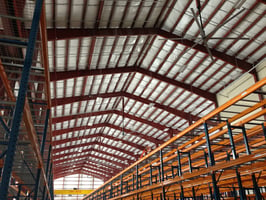What Is Sweating Slab Syndrome and Why Should You Care? If your facility’s concrete floors are...
The Effects of Sweating Slab Syndrome
We are now in the middle of summer and for those of you that work in industrial environments like a warehouse or distribution center you are most likely familiar with Sweating Slab Syndrome (SSS). This blog will discuss the effects of Sweating Slab Syndrome as well as how to avoid SSS through some practical tips.
How Does Sweating Slab Syndrome Happen in Your Facility?
The build-up of moisture from temperature swings doesn’t just affect the concrete floor of an industrial space, it can affect machinery within a facility. In addition to the primary safety and health concerns of moisture on concrete slabs, it can also result in damage to inventory, machinery, and the structure itself.
Anything that cools down after a hot humid day experiences sweating slab syndrome, even industrial equipment, and building materials. The following factors also contribute to sweating slab syndrome:
Moisture Content: Any type of moisture such as oil from machinery or water from condensation as you would guess is the underlying cause of sweating on concrete floors slabs and machinery. This usually happens when concrete slabs and the other materials that sweat reach dew point temperature. Additionally, moisture can cause mold problems, fungal growth, and increased bacteria growth.
Relative Humidity: Usually, warm, moist air and relative humidity enter a structure through several openings (windows, doorways, and vents) and, as the air diffuses throughout the structure, it condenses on any surface that is at or below the dew point temperature.
What are the Effects of Sweating Slab Syndrome?
Now that summer has arrived, most parts of the country are experiencing temperature swings (cool nights and hot days) that cause sweating slab syndrome. The symptoms of sweating slab syndrome are a build-up of condensation as industrial machinery literally sweats from extreme temperature changes.
“Imagine a forklift sweating oil onto the floor, machinery sweating grease. These lubricants combined with sweating machinery and slabs create very serious hazards for employees.” - Jason Hornsby, Industry Expert
How do you Avoid Sweating Slab Syndrome?
Combating a sweating slab and its negative impact on valuable products as well as reducing workers' compensation claims are very important issues for industrial environments. Here are some practical ways you can counter these issues related to sweating slab syndrome.
Try to get ahead of moisture:
Remove any deposits from the surface of your slabs. A good way to do this is to use commercial cleaning agents to scrub your floors and vacuum your machines. This is an important safety measure for employees as well as protecting your assets from damage.
Check out how air flows in your facility:
Sweating slabs occur because the air inside the structure can’t easily flow out. If the air movement inside the building isn’t sufficient, it is necessary to find a means to de-stratify the air, such as an HVLS Fan.
Get a High Volume, Low Speed (HVLS) fan:
HVLS fans also increase the surface evaporation rate. These fans provide a cost-effective way to keep your structures cool while preventing the build-up of moisture on your floors.
Install commercial dehumidification units:
Although these are costly units that add to your overall energy bill, they are known to alter the interior building environment which may help reduce or eliminate SSS.
Use low-permeance, low-slab retarders in your stores:
This can prove particularly effective where products are stored directly on the floor. They tend to reduce the possibility of moisture rising and condensing beneath stored products.
“For my clients in the South, sweating slab is a big issue due to the humidity. If they have a high volume, low-speed fan they can come into work, turn it on and within an hour or less, it’s totally dry. Some people even say that if they know they’re going to be getting those temperature swings that certain time of the year then they could just leave the fans on all night and the floors won’t sweat.”- Jason Hornsby, Industry Expert
Sweating slab syndrome can be a challenge in facilities that do not take the proper measures to prevent it. With the right kind of solutions, employees and goods will stay safe and work can be productive. All this without worrying about the hazards of SSS.
Are you experiencing Sweating Slab Syndrome in your facility? Leave your comment below.
Visit www.macroairfans.com today to find your fan.


